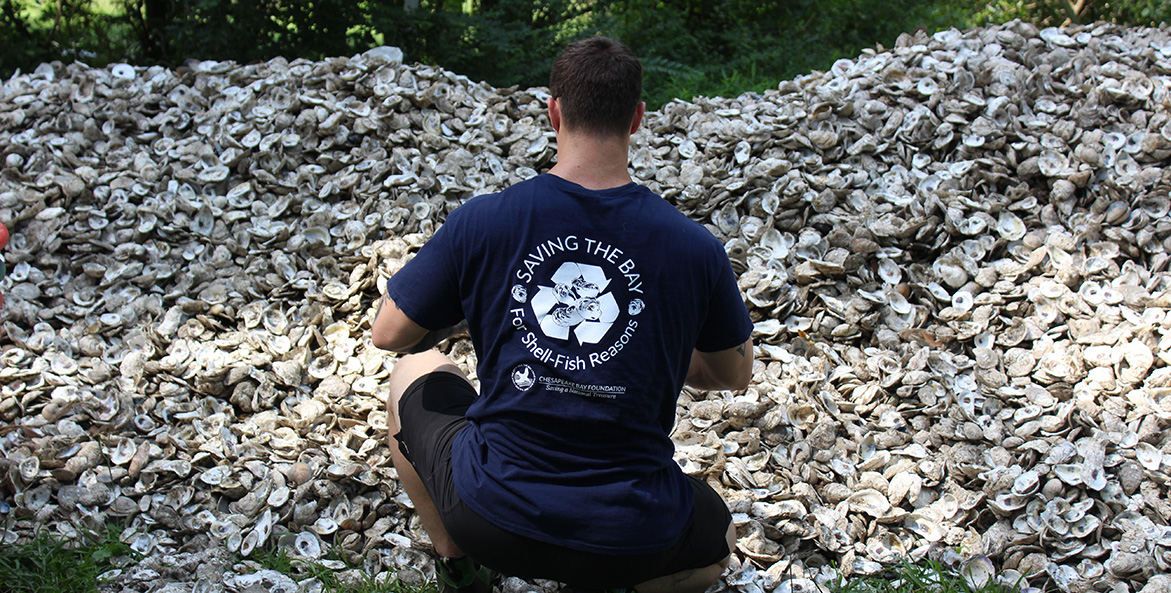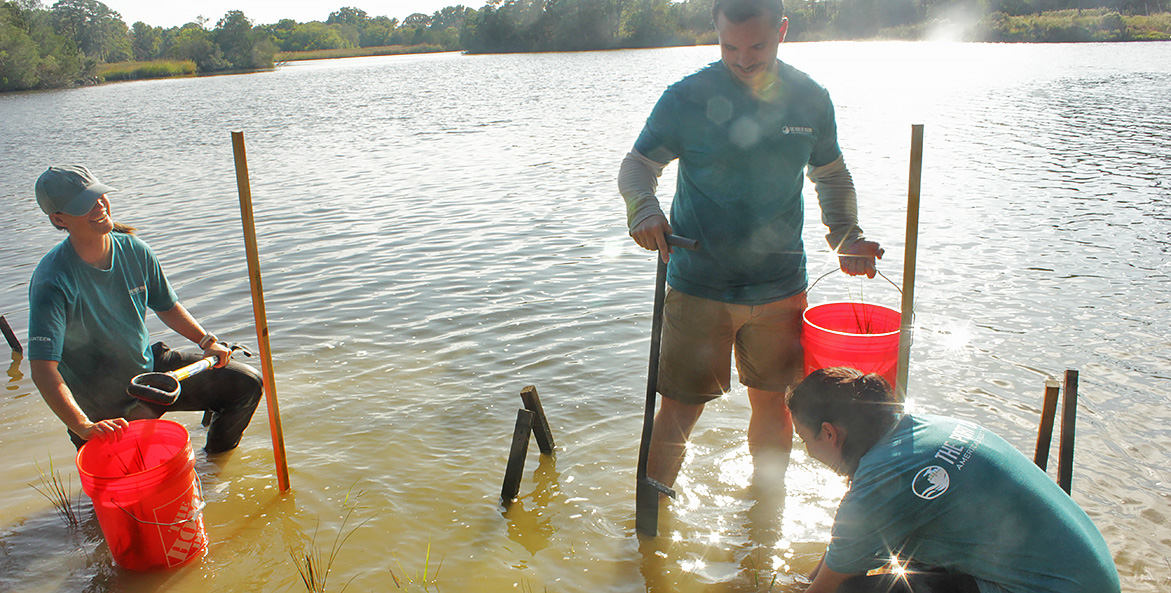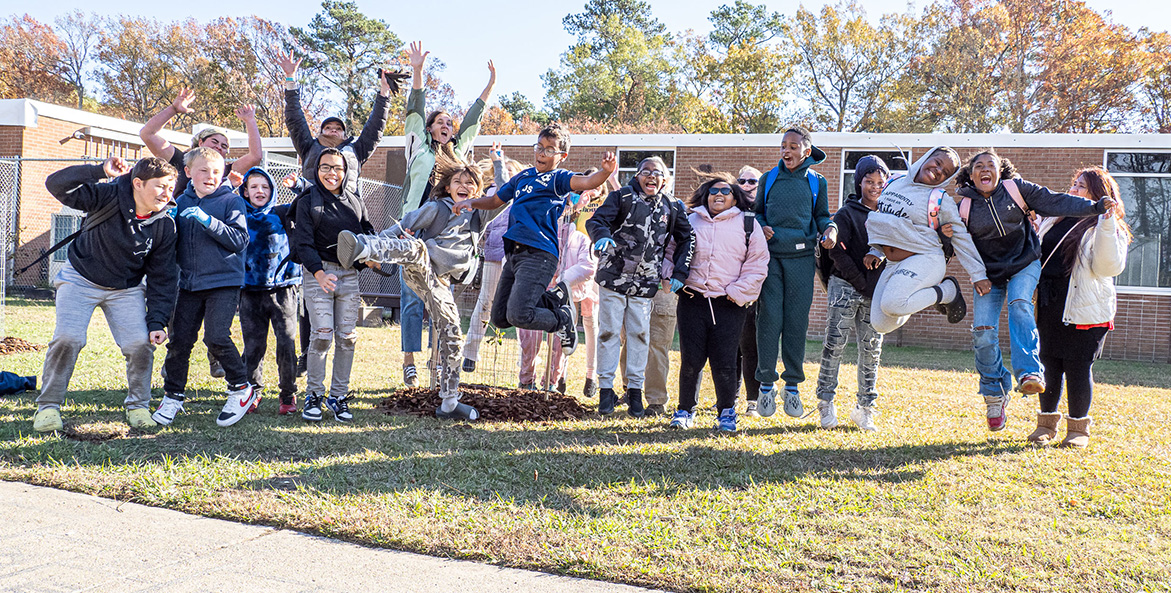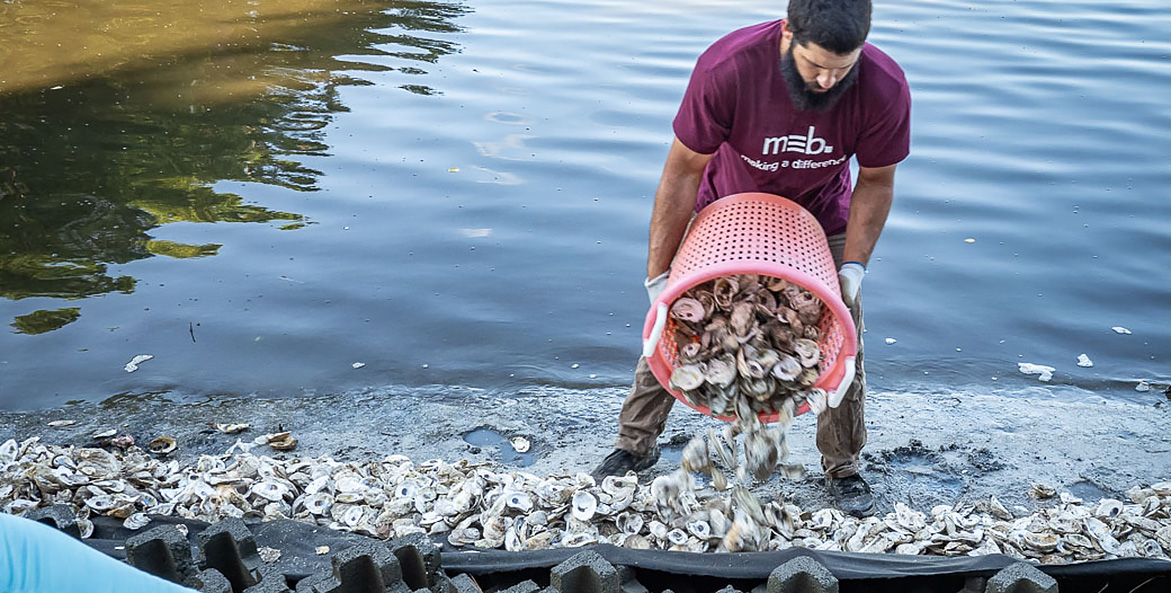Hampton is located at the southern end of the Chesapeake Bay in Virginia, a region where residents have long relied on its waterways for food, recreation, and economic well-being. Hampton faces many challenges for water quality, including a dense population with approximately 138,000 residents living in a 51-square mile area. Polluted runoff from streets, parking lots, and buildings is one of the city's biggest threats to clean water.
Here's a look at some of the current projects we're involved with.
Oyster Restoration
Oyster reefs originally present in the Hampton River were decimated over time as oyster shells were removed to be used as landfill, in construction, and for other purposes. Oysters need hard substrate, such as other oyster shells, cement or rocks for spat (baby oysters) to set and grow. If placed on soft bottom, oysters tend to become buried and they die. Oyster reefs benefit the river ecosystem by providing complex structures that protect baby oysters and other fish and shellfish species from predators.
In 2023, CBF received funding from the Cabell Foundation and Audi Environmental Education Fund to begin work on large-scale oyster restoration efforts in the Hampton River. The project will restore 10 acres of oyster reefs to the depleted areas where they once existed. The new reef habitat will be populated with approximately five million spat-on-shell. These are baby oysters attached to recycled oyster shells that are nurtured in setting tanks, then placed on the sanctuary reefs to contribute to the creation of robust oyster reef communities. The new oyster reef acreage CBF proposes for the Hampton River will help rebuild productive and sustainable fisheries.
- CBF worked with Hampton University students from May through October 2023 to conduct a spat catcher survey at nine sites throughout the Hampton River. A spat catcher is a cage containing oyster shells designed to attract baby oysters. The data collected show where oyster recruitment occurs in the river and where we should focus our restoration efforts—and is informing the placement of CBF’s planned new oyster reefs in the Hampton River.
- CBF submitted our Joint Permit Application to the Virginia Marine Resources Commission (VMRC) in autumn 2023 for the three initial reefs proposed for the Hampton River. These first three reefs are upstream near the Pine Cone Harbour condominium complex and total 2.38 acres. We received this permit in September 2024.
- A second Joint Permit Application has been prepared and submitted for three additional reefs, adjacent to Hampton University. These three reefs will cover 2.23 acres.
In September 2024, the National Fish and Wildlife Foundation awarded CBF a grant to bring 2.5 million baby oysters to two new sanctuary reefs in the Hampton River as part of our large-scale oyster restoration project.

CBF's oyster shell recycling program recovers shell for oyster restoration projects.
Ryan Westpfahl/CBF Staff
Oyster Shell Recycling
Oyster shells are a limited resource but remain key to increasing the Bay’s oyster population, supporting the wild oyster fishery, and assisting aquaculture operations. The tight supply and cost of oyster shell presents a challenge for large-scale oyster restoration work. While a growing number of restaurants recycle oyster shells, far too many shells still end up in landfills.
To help increase the supply of oyster shells, CBF runs the Save Oyster Shells program, one of several volunteer-based shell recycling programs in Virginia. Volunteers pick up empty oyster shells from restaurants, oyster roasts, and other businesses. These shells are then cleaned, cured, and prepared for planting on oyster reefs.

Volunteers plant plugs of smooth cordgrass as part of a living shoreline project at Bluebird Gap Farm.
Vanessa Remmers/CBF Staff
Living Shorelines
Living shorelines are a natural approach to protecting tidal shorelines from erosion. Compared to hardened shorelines lined with riprap, bulkheads, and concrete, living shorelines offer environmental benefits that include cleaning the water by settling sediment and providing habitat to critters like nesting turtles, shorebirds, and blue crabs. Living shorelines also protect properties from the effects of sea level rise and erosion. Living shorelines are created by planting native wetland plants, wetland grasses, shrubs, and trees at various points along a shoreline. Plantings are often paired with carefully placed bioengineering materials, such as manmade coconut-fiber rolls (or biologs), to protect vegetation and soils or in some cases oyster shell.
In fall 2024, CBF completed installation of a living shoreline project at Bluebird Gap Farm, a city-owned park on Newmarket Creek. Our volunteers helped install the 158-foot living shoreline, placing manmade logs made of natural materials, 100 tons of sand, and hundreds of bushels of loose oyster shells, and planting 1,000 wetland plant plugs. CBF was honored to partner with the City of Hampton to bring this project to fruition.
In 2025, CBF staff will start installation of a living shoreline along Pine Cone Harbour on the Hampton River. The proposed project, funded by the Blocker Foundation, will install 885 linear feet of living shoreline, 7,040 square feet of wetland vegetation, 4,493 square feet of buffer, and 0.09 acres of oyster reef. The oyster reef will be comprised of recycled shells collected through CBF’s Save Oyster Shells program. Additionally, the shells will be bagged using an innovative, plastic-free material designed and produced by Natrx. These bags, made of basalt rock, present an opportunity to combine strength and stability with an inert and environmentally safe material.

Students from Francis Asbury Elementary School show their enthusiasm after a tree planting at their school.
Sue Mangan Photography
Tree Plantings
In November 2024, CBF and Hampton City Schools partnered with Enterprise Mobility and the Arbor Day Foundation to plant 49 trees at Luther W. Machen Elementary School as part of Enterprise Mobility’s Urban Tree Initiative program. CBF coordinated the planting efforts and Enterprise Mobility employees helped install the trees in the ground.
In total in 2024, CBF and partners planted 120 trees at four Hampton City schools, including Paul Burbank Elementary, Jones Middle, and Francis Asbury Elementary, helping protect the grounds from erosion and broadening student access to green space that cleans the air and beautifies their learning space.
To see a map of these and other projects, visit our Roots to Reef storymap.
Learn about other recent projects with our Hampton Roads Urban Restoration Project storymap.



